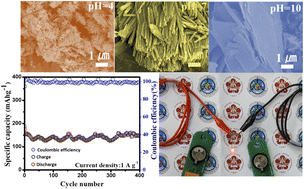Two-dimensional metallic VTe2 demonstrating fast ion diffusion for aqueous zinc-ion batteries†
Abstract
Aqueous zinc ion batteries (AZIBs) have gained considerable attention due to the high demand for safety and eco-friendliness. However, the lack of reliable cathode materials is the main challenge in boosting the performance of the batteries. In response to these challenges, for the first time, this work reports the synthesis of VTe2 by a facile hydrothermal approach. The morphology of VTe2 can be customized by tuning the adequate pH value from nanorods synthesized in an acidic solution (pH = 4) to nanosheets synthesized in an alkaline solution (pH = 10). Impressively, as a potential cathode material for AZIBs, nanosheet VTe2 AZIBs deliver a high specific capacity of 200 mA h g−1 (at 0.2 A g−1) and a remarkable cycling duration of up to 400 cycles (at 1 A g−1), which is attributed to the layer structure and fast Zn2+ diffusion coefficient (DZn2+ ≈ 8 × 10−8 cm−2 s−1). Through the DFT calculation, the energy-preferable path of Zn2+ ions migrating in VTe2 is determined due to the low hopping energy barrier of 0.55 eV. Overall, for the first time, this work has proposed a reliable method to synthesize VTe2 and has taken a promising step in the design of electrodes for AZIBs and even for other metal-ion batteries.



 Please wait while we load your content...
Please wait while we load your content...